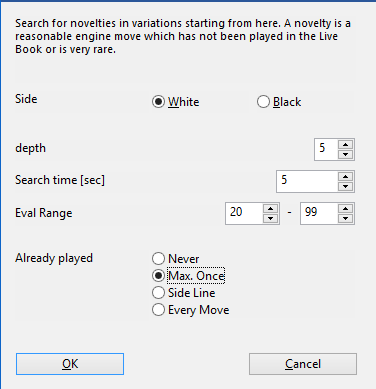|
Prospecting for innovations |

|

|
|
|
Prospecting for innovations |

|

|
Prospecting for innovations
Many popular opening systems have been thoroughly analysed and it is very difficult to find theoretical innovations in preparation against a theoretically knowledgeable opponent with which one can surprise him or her. One approach to finding them is the search for rare or even as yet unplayed moves which still get a good evaluation from an engine. This is the route taken by many players, above all professional chess players. You try out various continuations and ideas in the opening variation you have chosen and follow the evaluations of the engine. This method offers some advantages, but also takes up a lot of time.
The program now offers the possibility to carry out the search for potential theoretical innovations automatically.
This new – pre-opening extremely important – innovation is called “Novelty Mining” because it reminds one of the panning for nuggets of gold in a heap of river sand.
Procedure
Load into the board window an opening position which is relevant either for your repertoire or for preparation for an opponent. In the notation window click on the tab “LiveBook”. There you will find the new entry “Novelty Mining”.

After the click, first of all the settings dialog is started. Here you can specify exactly how the search for a playable (usable) innovation is to be carried out by the default engine.

The following settings are possible:
| • | The Side for which a usable novelty should be found. |
| • | Depth sets the nesting depth of the variations which will be investigated from the current position. The resulting variation trees can be flatter if not sufficient games have been played with them. |
| • | Evaluation range fixes the evaluation interval in hundredths of a pawn: if a move calculated achieves a value in this range it counts as a possible. For White and Black these ranges are different and are automatically suggested when colours are changed. The more aggressively or optimistically you set this interval the fewer hits are found , but these nuggets are all the more important. |
| • | Already played refers to the number of possible games already played: if “Never” the move should not have been played in good games. “Max. once” means that one previous game has been found. “Side Line” concerns less than 5 percent of all games. With “Every move” all limitations are off. All moves played are analysed. That results in an automatic engine check of the variations which follow. |
Hint: The engine search for novelties works very efficiently. Normally one would set up a search with many multi-variations in order to explore widely for alternatives. The multi-variation search, however, gives exactly as much calculating time to the main variation as to all the other continuations. So, side lines are calculated clearly less deeply.
When mining the frequently played variations are excluded according to the setting “Already played” via the UCI interface. That immediately directs the whole of the calculating power into the alternative candidates.
Example: After the moves 1. e4 c5 2. Nf3 e6 3. d4 cxd4 4. Nxd4 Nc6 5. Nc3 Qc7 6. f4 d6 mining finds the nugget 7.g4 with an evaluation of >= 0.4.
If you carry out a “normal” search with Stockfish after 6... d6, this move which has never been played is also suggested.

During the search a status window is displayed -> Technical messages.
There you will see the progress and when appropriate the display of possible alternative continuations or candidate moves. The results are copied to the notation; you can if you wish choose to save them.